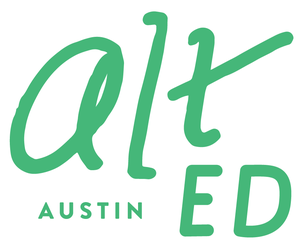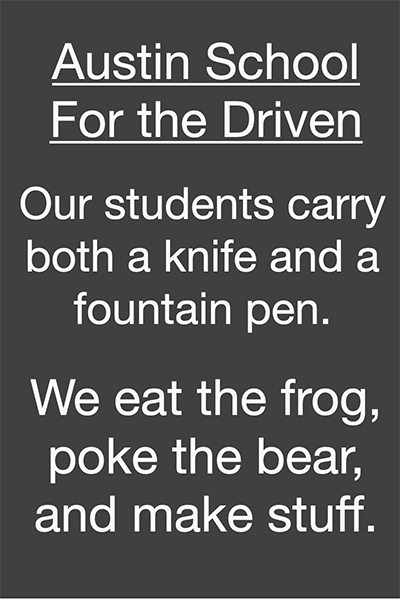A conversation with Dr. Karen Rayne about transgender students and SB6
/Of the Texas respondents, 73 percent of transgender schoolchildren said they’d experienced mistreatment because of their gender identity, with nearly half saying they’d been physically attacked and 14 percent leaving a school because of how they were treated.
Another 14 percent of those surveyed said a professional—like a psychologist or religious adviser—had tried to stop them from being transgender, and 41 percent said they experienced “serious psychological distress” sometime in the month before they took the survey.
—Lauren McGaughy, “Transgender Texans skip the bathroom to avoid violence, new survey says,” Dallas News, January 26, 2017
With all the controversy heating up in the Capitol over SB6, and growing concern over the problems faced by transgender kids in Texas schools, I decided to talk with Dr. Karen Rayne, a local educator and author with expertise in gender and sexuality issues, particularly related to teenagers. Below is some background on the issue, followed by an edited account of our conversation.
Many thanks to Dr. Rayne for her time and thoughts. Alt Ed Austin highly recommends her UnHushed, “Sex Ed Done Right,” classes and her book, Breaking the Hush Factor.
The debate over SB6, the Texas legislature’s so-called “bathroom bill,” is one that continues to dominate political media, but more important, it is one with sweeping consequences for students across the state. If approved, the bill would prohibit trans people from using bathrooms and locker rooms matching their identities in schools and other public buildings. The law also allows Texas businesses to ignore local ordinances that protect trans citizens’ rights to choose facilities in keeping with their identities.
Nearly 150,000 American teenagers (1 in every 137) would identify as transgender according to a new report from UCLA’s Williams Institute, cited in a recent, enlightening New York Times article by Niraj Chokshi.
Last week the White House weighed in on the controversy, declaring that the federal government would no longer support a stance by the Obama administration that defended transgender students’ rights under 1972’s Title IX, which bars discrimination based on sex for schools that receive federal funds. The decision to stop supporting the Title IX argument affects not only states and localities that want to pass laws requiring that students behave according to the gender listed on their birth certificates, but it also affects an upcoming Supreme Court case originating in Gloucester County, Virginia, in which Gavin Grimm was barred from using the boys’ bathroom at his school.
Last week national attention again focused on transgender rights in Texas. Trinity High School junior Mack Beggs, the 17-year-old boy who competed in and won the girls’ state wrestling championship, was in the news because he had to compete under the gender listed on his birth certificate.
I asked Dr. Rayne to tell me a little about how she sees kids and schools reacting right now to the SB6 issue in Texas.
The reaction of a lot of kids, including my teenage daughter, is “Why should anyone care?” The interest in where someone chooses to go to the restroom is oddly invasive, putting the government in someone else’s personal space. It’s strange that we’re in a place where Republicans are no longer the party of small government in many areas, including this one.
The best-case scenario for schools in the future is probably that transgender kids’ classmates will not care at all and will not comprehend that this was ever a serious controversy. I think in the long run that’s where we’re headed, but we’re not there yet.
In general, how do schools and students cope with the process of gender transitioning?
A number of schools are good at supporting students—both public and private schools. The problem with public schools is that they are so large, with very diverse communities. So, in a large community of students and educators, there will always be some people who are not supportive. I do find that in some smaller schools you have a whole community that is supportive of trans kids.
Austin ISD has an array of LGBTQ resources for students and parents, and hosts its own Pride Week in October. Area alternative schools that specifically welcome LGBTQ kids and faculty include, but are not limited to, KọSchool, Skybridge Academy, Griffin School, Integrity Academy, and Radicle Roots Community Schoolhouse.
My experience is that younger kids—elementary school age—are still strongly under their parents’ influence, so if parents are willing and strong advocates, the kids follow their lead and become strong advocates for themselves. Parents can talk with school administrators and are often able to make transitions easier. And of course, transitioning isn’t quite as salient for a six- or seven-year-old, and most other kids that age are fine with it because fewer judgments are made in that pre-adolescent stage.
The older kids are when they transition, the tougher the social, cultural, and biological structures are. The stresses and strains that play out in social lives at school are difficult for all teenagers, and they are less under their parents’ protective wings, so there’s just less that parents can do, even if they want to be supportive.
I think we have to remember that teens have a rough time navigating identity issues, even without the added complication of gender transition. There are issues with self-esteem and self-compassion, and figuring out who you are in relation to the rest of the world. For all teens it’s a socially and politically charged time, and for transgender teens the stresses are multiplied.
Out Youth is a Central Texas organization serving LGBTQ young people with a variety of programs. Right now, they are sponsoring a campaign called #TakeMyHandTexas, and giving away free buttons to symbolize support for transgender rights, explaining: “When you wear a #TakeMyHandTexas button, you’re showing that not only are you an ally to this community, but you’ll also gladly accompany someone to any gender-specific space they feel uncomfortable going to alone, including the bathroom.”
How can allies talk with legislators, friends, and family about issues of civil rights, privacy, and fairness when it comes to the transgender community?
It really depends on whom you’re talking to. Some people are lacking good information and quite open to incorporating new ideas when they’re presented. So in that case, statistics and examples you might find in news coverage are helpful. I think one of the best books on the subject is Sam Killermann’s A Guide to Gender: The Social Justice Advocate’s Handbook, which is coming out in a new edition on March 8.
We can talk about the real-world impact of SB6 on vulnerable students, and we can talk about the fact that if protecting people against sexual predators in private spaces like restrooms is the goal, those laws are already on the books. If you think someone is open to new information, then have some solid facts available.
A 2015 Media Matters report found that in 17 school districts with a total of 600,000 students, protections for trans people resulted in no problems with harassment in bathrooms or locker rooms as a result of the protections.
I think one of the biggest problems this kind of legislation introduces is that it encourages and gives license to ordinary people to police others’ behavior.
One real-world impact that people may not be aware of is how laws like the one proposed in Texas stratify gender-nonconforming communities into those who “pass” in the larger community and those who do not. So, for example, if you have undergone hormone treatments or had surgery as part of your transition and you look very feminine, you will be much less likely to be questioned or attacked for using the women’s restroom, and more likely to be questioned or attacked for using the men’s. Transgender women who still look more masculine and cis-gender women who happen to look and dress in a more traditionally masculine way face questions and attacks no matter where they go.
Two advocacy and support organizations with great collections of resources for students, families, and schools are Trans Youth Equality Foundation and Gender Spectrum.
And what about talking with people who don’t seem as eager to receive new information, facts, and statistics?
There are people who have a perspective on gender that is narrow and specific, so for them the idea of a transgender person is an emotional and cultural assault. I think it’s usually not about religious doctrines—I’ve found many religious communities that are strong supporters of transgender people. A lot of religious people hear and feel salience in the notion that “God made me a girl, but then my body did not follow instructions.” Often religious communities support people trying to align themselves physically with what they feel God intended for them.
So, for those who feel assaulted by the idea of transgender people, I think it’s more about inherited cultural values and expectations than religion. We often grow up tied to our culture’s gender structures, without much evidence as to why. In that case, it’s hard to break through unless something happens that makes them question those values and structures.
Do you have any predictions on what we’ll see in terms of both the politics of SB6 and the culture as relates to transgender students?
I would never underestimate how conservative the legislature is, so I would really be stunned if the bill doesn’t pass. But that said, the way our school districts run is somewhat independently, so the implementation might vary a lot.
It’s an interesting time to be alive and looking at these issues. And overall, I think we are coming into a time of more openness. I see us swinging toward openness and acceptance among young people toward each other and toward diversity in terms of gender and sexuality. The current political climate is about reacting to that swing toward openness, and we may lose some footing for a while, but in the long run, openness and compassion and diversity will overcome.
Recommended Reading:
- Sam Killermann, A Guide to Gender: The Social Justice Advocate’s Handbook, updated version due out March 8, 2017.
- “Bathroom Bill” Legislative Tracking, National Conference of State Legislatures (updated regularly as new legislation is introduced); the site also includes some helpful explainers about the history of this type of legislation.
- Niraj Chokshi, “One in Every 137 Teenagers Would Identify as Transgender, Report Says,” New York Times, February 23, 2017.
- German Lopez, “Texas’s anti-transgender bathroom bill, explained,” Vox, January 5, 2017.
- Carlos Maza, “Debunking The Big Myth About Transgender-Inclusive Bathrooms: Experts Call Bathroom Myth ‘Beyond Specious,’” Media Matters, March 20, 2014.
- John Wright, “New Data Suggests ‘Bathroom Bill’ Would Burden Nearly All Transgender Texans,” Texas Observer, January 26, 2017.
- “Understanding Transgender Access Laws,” New York Times, February 24, 2017.
- Maria Danilova and Sadie Gurman, “Trump Administration lifts transgender bathroom guidance,” Austin American Statesman, February 22, 2017.
- And some federal resources on bullying and LGBT youth are also available.
Finally, for some good laughs with a Texas-style political edge, don't miss this short web ad by Oscar-nominated Austin filmmaker Richard Linklater!
Shelley Sperry























